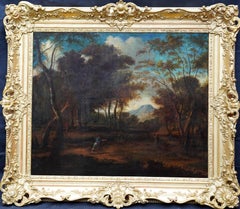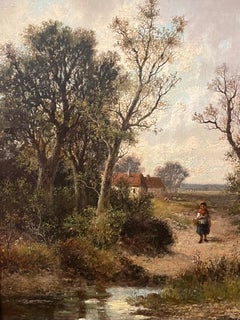Jean François Millet Landscape Paintings
to
1
Overall Width
to
Overall Height
to
1
1
1
1
1
6
678
605
307
232
1
1
Artist: Jean François Millet
Diana Hunting in Wooded Landscape - 17thC Old Master French art oil painting
By Jean François Millet
Located in Hagley, England
This superb French Old Master oil painting with excellent provenance is by Jean Francois I Millet. It was painted circa 1675 and is a figurative landscape depicting Diana hunting in ...
Category
17th Century Old Masters Jean François Millet Landscape Paintings
Materials
Oil
Related Items
Landscape Near Felday, Surrey
By Abraham Hulk the Younger
Located in Hillsborough, NC
Dutch/English artist Abraham Hulk the Younger (1851-1922) is most known for landscapes of the British countryside. This work is one of a pair (the second work is also available by s...
Category
Late 19th Century Old Masters Jean François Millet Landscape Paintings
Materials
Canvas, Oil
$2,240 Sale Price
20% Off
H 27 in W 22.75 in D 2.13 in
View of Ponte Milvio in Rome
Located in Roma, RM
Northern painter active in Rome in the second half of the 17th century, View of Ponte Milvio
Oil painting on canvas 73 x 97 cm in coeval Roman Salvator Rosa frame.
Category
18th Century and Earlier Old Masters Jean François Millet Landscape Paintings
Materials
Canvas, Oil
Large 17th century Italian old master - Noli me tangere, Christ in the garden
By Pier Francesco Cittadini
Located in Aartselaar, BE
Large 17th Century Italian Old Master, The Garden - Noli me tangere, Pier Francesco Cittadini (attr.)
Description
In the stillness of a garden in bloom, Noli me tangere captures a p...
Category
17th Century Old Masters Jean François Millet Landscape Paintings
Materials
Canvas, Oil
$7,773
H 31.89 in W 40.56 in
18th century English marine Battle scene between Dutch and British warships
By Francis Swaine
Located in Woodbury, CT
Attributed to Francis Swaine (British, 1725–1782)
Naval Engagement at Sea, 18th century
Oil on panel
In this evocative seascape, a cluster of ships—flags raised, cannons fired—conve...
Category
1760s Old Masters Jean François Millet Landscape Paintings
Materials
Oil, Wood Panel
Venice San Giorgio Marina Canaletto 19th Century Paint Oil on canvas Old master
Located in Riva del Garda, IT
View of Venice with the Island of San Giorgio Maggiore
Follower of Canaletto (Venice, 1697 – Venice, 1768)
Venice - 19th century
oil on canvas
29 x 39 cm. - Framed 40 x 50 cm.
Wel...
Category
19th Century Old Masters Jean François Millet Landscape Paintings
Materials
Oil
$4,726 Sale Price
20% Off
H 15.75 in W 19.69 in
Alexander The Great Persians Fontebasso 18th Century Paint Oil on canvas
Located in Riva del Garda, IT
Francesco Fontebasso
(Venice 1709 - Venice 1769)
Alexander the Great grants clemency to the Persians
Oil on canvas
108 x 153 cm.
In frame 120 x 164 cm.
Fascinating for its interest...
Category
18th Century Old Masters Jean François Millet Landscape Paintings
Materials
Oil
$18,034 Sale Price
20% Off
H 47.25 in W 64.57 in
Bacchanale Mythological Carpioni Paint Oil on canvas 17th Century Old master Art
Located in Riva del Garda, IT
Giulio Carpioni (Venice, 1613 - Vicenza, 1678), Attributable to
Bacchanale
Oil on canvas 98 x 132 cm. - In frame 120 x 154 cm.
This high-quality, beautifully preserved painti...
Category
17th Century Old Masters Jean François Millet Landscape Paintings
Materials
Oil
$15,737 Sale Price
20% Off
H 47.25 in W 60.63 in
St Michael's Mount, Cornwall Seascape Oil
Located in York, GB
This early 20th century oil on canvas depicts a nautical scene with a view of St Michaels Mount beyond.
Although as yet, not attributed to a parti...
Category
Early 20th Century Old Masters Jean François Millet Landscape Paintings
Materials
Oil
Christ Supported by an Angel in the Garden of Gethsemane, On Slate
Located in Stockholm, SE
This evocative Veronese School painting captures the moment in the Garden of Gethsemane when Christ, overwhelmed with sorrow, prays to God before his arrest and crucifixion. Supporte...
Category
Early 17th Century Old Masters Jean François Millet Landscape Paintings
Materials
Slate
$8,251
H 20.48 in W 16.15 in
Early 20th Century Oil Painting Grand Canal Venice (2-Sided)
By Richard Pearsall
Located in Soquel, CA
Early 20th Century Oil Painting Grand Canal Palazzos and Gondolas , Venice Italy (2-Sided)
Peaceful and substantial romantic scene of a gondola alo...
Category
1930s Old Masters Jean François Millet Landscape Paintings
Materials
Oil, Board
$1,480 Sale Price
20% Off
H 16 in W 19 in D 1 in
Early 20th Century Oil Painting Grand Canal Venice at Dusk (2-Sided)
By Richard Pearsall
Located in Soquel, CA
Early 20th Century Oil Painting Grand Canal at Dusk, Venice Italy (2-Sided)
Peaceful and substantial romantic scene of a gondolas along Venice's iconic Grand Canal at Dusk by Richar...
Category
1930s Old Masters Jean François Millet Landscape Paintings
Materials
Oil, Board
$1,560 Sale Price
20% Off
H 16 in W 19 in D 2 in
17th Century by Jacob de Heusch Pair of Landscapes Oil on Canvas
Located in Milano, Lombardia
Jacob De Heusch (Utrecht, Netherlands, 1657 – Amsterdam, Netherlands, 1701)
Title: Pair of Landscapes
Medium: Oil on canvas
Dimensions: without frame 50 x 8...
Category
17th Century Old Masters Jean François Millet Landscape Paintings
Materials
Oil, Canvas
$48,792 Sale Price
20% Off
H 19.69 in W 31.5 in
Jean François Millet landscape paintings for sale on 1stDibs.
Find a wide variety of authentic Jean François Millet landscape paintings available for sale on 1stDibs. You can also browse by medium to find art by Jean François Millet in oil paint, paint and more. Much of the original work by this artist or collective was created during the 18th century and earlier and is mostly associated with the Old Masters style. Not every interior allows for large Jean François Millet landscape paintings, so small editions measuring 40 inches across are available. Jean François Millet landscape paintings prices can differ depending upon medium, time period and other attributes. On 1stDibs, the price for these items starts at $15,439 and tops out at $15,439, while the average work can sell for $15,439.
Questions About Jean François Millet Landscape Paintings
- 1stDibs ExpertJanuary 27, 2025Jean-François Millet is famous because of his Realist artwork. One of the founders of the Barbizon school, he was a major force in the 19th-century French Realist art movement. He is best known for his depictions of rural people working in the fields, such as The Gleaners, The Angelus and Shepherdess with Her Flock. Shop a collection of Jean-François Millet art on 1stDibs.
- 1stDibs ExpertNovember 20, 2024One of the most famous Realism paintings made by Jean-François Millet is called The Gleaners. It depicts three peasant women working in a field. Millet produced the oil painting in 1857, and it is now part of the collections of the Musée d'Orsay in Paris, France. Other notable works by the French artist include The Angelus, Shepherdess with Her Flock and Man with a Hoe. On 1stDibs, explore a range of Jean-François Millet art.

